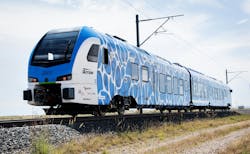Full Charge Ahead: Advancements in Battery-Electric Trainsets for Rail Transit
In North America, the use of battery-electric trainsets is growing to help solve energy goals and enable increased operation flexibility with minimum infrastructure investment. In the January/February issue of Mass Transit magazine, our article discussed dual-mode motive power, including battery hybrid trains. These hybrid trainsets can have battery systems paired with other power sources, such as diesel, overhead catenary, third rail electricity or even hydrogen like the Stadler Zero Emission Multiple Unit (ZEMU) recently tested at the Transportation Technology Center (TTC) and delivered to San Bernadino County Transit Authority (SBCTA).
Full battery-electric trainsets are also emerging. An example is Metra in Chicago that recently ordered Battery Electric Multiple Units (BEMU) from Stadler. This article will discuss the opportunities with battery technology and the continued focus on battery safety.
New flexibility for rail operations
A challenge passenger rail operators face is expanding service with extended and new lines but also fitting within budget constraints for new infrastructure costs. One example is extending the service of an overhead wire catenary line, which would normally require the added costs of new power infrastructure. Trainsets equipped with battery electric storage systems (BESS) offer a unique opportunity to overcome this challenge cost effectively.
An example of this type of operation utilizes the Stadler FLIRT Akku BEMU currently in operation in Schleswig-Holstein and Mecklenburg-Vorpommern in Germany. While in electrified territory, the overhead catenary powers the trainset and keeps the BESS charged. While in non-electrified territory, the BESS powers the trainset. This methodology has been extremely valuable to have free flowing service with mixed electrified and non-electrified lines without having to change motive power, which can add significant time to commutes. Both Germany and the U.K. have implemented this type of operation, with additional trainsets on order to Denmark and Austria.
In North America, Caltrain will be piloting the first bi-level dual electric and battery trainset to expand service in non-electrified territory. Funding was approved by the California Transportation Commission (CalSTA) for one Stadler BEMU trainset to operate between San Jose to Gilroy, Calif. Another goal of the project is to serve as a demonstration train for expanded battery-electric rail service in the future.
Included in the project is testing the BEMU at the TTC. This ability to test at the TTC is invaluable because it does not interrupt Caltrain revenue operations to perform on-track testing and enables the train builder to work in normal day-time hours with a dedicated test track, resulting in a quicker start to revenue operations. A unique aspect of the TTC is that it is the only railway testing facility in the world that has both overhead wire catenary and third rail electrified test tracks. An example is the Railroad Test Track (RTT), which is a 13.5-mile loop with adjustable voltage AC overhead wire catenary.
Unwavering focus on battery safety
BESSes have long served as the underlying power source for electric automobiles. Their success in passenger vehicles has paved the way for broader applications, including fleets of electric buses and now BESS-equipped passenger trains. With the new opportunities for meeting operation, cost effectiveness and energy goals, they also include important safety considerations when a system fails, including experiencing a fire.
The overall rate of fire incidents of BESS vehicles is less than fossil fuel vehicles; however, the nature of lithium-ion battery fires is distinctly different from conventional fires. Traditional fossil fuel fires can often be contained with standard firefighting measures. In contrast, lithium-ion battery fires can reach extreme temperatures and may experience reignitions. These complexities stem from a phenomenon known as thermal runaway.
Thermal runaway refers to an escalating chain reaction within the battery cells. Once a single cell ignites or breaks down due to excessive heat or physical damage, it can rapidly transfer heat to adjacent cells, causing them to short-circuit in turn. The outcome is a rapidly intensifying fire that is extremely difficult to contain if responders are unprepared or lack the proper equipment. New training and technology are needed for addressing battery vehicle files.
The TTC serves as the training and testing facility for emerging technologies. An example includes the Ambipar Response Firefighting Robot recently demonstrated at the 2024 TTC Conference and Tour. Its ability to be remotely operated enables firefighters to be a safe distance while also delivering needed water up close.
Multiple lithium-ion battery fire incidents in vehicles have been documented around the world, shedding light on the unique challenges posed by these systems. Data from the U.S. National Transportation Safety Board shows that there are approximately 25 fires for every 100,000 electric automobiles sold. However, it is important to note that there are approximately 1,530 fires for every 100,000 gas-powered vehicles sold. Additionally, there are approximately 250,000 battery-electric buses in operation globally—of which 27 battery fires have occurred as of January 2024.
Recent battery bus fires include nine lithium-ion buses that caught fire in October 2024 while being stored in a depot in Taiwan. Another example was a fire that occurred in March 2024 at the San Diego Airport parking garage, where three hybrid airport shuttle vehicles were stored. Similar to automobiles, non-battery bus fires have a higher frequency with an estimated 1,075 bus fires a year. To date, there has not been a reported BESS fire on a battery-electric trainset. However, utilizing the lessons learned from the automobile and bus sectors, it is paramount that rail transit stakeholders work together to prevent such a fire.
Another emerging risk is passengers bringing lithium-ion battery micromobility equipment, such as e-bikes and e-scooters, on passenger trains. In January 2024, an e-bike brought onboard a Toronto Transit Commission subway train caught fire. Luckily, no serious injuries occurred.
Battery safety has also recently come into the forefront, with the bipartisan lithium-ion battery bill recently passed by the U.S. House on April 28 with a vote of 365-42. H.R.1797 “Setting Consumer Standards for Lithium-Ion Batteries Act” focuses on setting the safety standard for lithium-ion battery micromobility devices.
Conclusion
Battery-electric trainsets offer many opportunities to achieve operation and energy goals for rail transit operators. However, with its unique characteristics, it also requires unique designs, operations and emergency response practices. Passenger rail has an opportunity to leverage best practices with the highway vehicle sector to overcome these challenges. This may include common standards, design practices, verification testing and emergency response training and technology.
To help with this collaboration, the TTC is hosting the TTC Battery Safety Summit May 19-20, 2026. The event is intended to bring together organizations of all transportation modes to discuss and achieve advancement in battery safety. More information can be found on TTC’s website.
About the Author
Matthew Dick
chief of strategy and development
Matthew Dick is the chief of strategy and development at ENSCO, with more than 14 years of experience in various roles, including rail division manager. He leads ENSCO’s expansion of service offerings, focusing on the Transportation Technology Center and subsidiary KLD Labs, Inc. Dick holds a B.S.M.E and M.S.M.E. from the University of Nebraska – Lincoln and is a licensed professional engineer, with more than 20 years of involvement in railroad research and technology, specializing in vehicle/track interaction, derailments and inspection technology.

